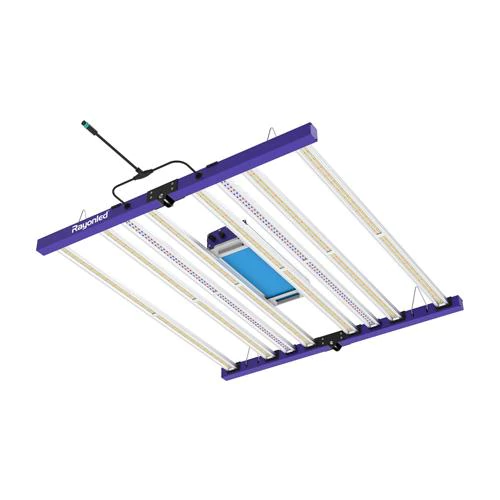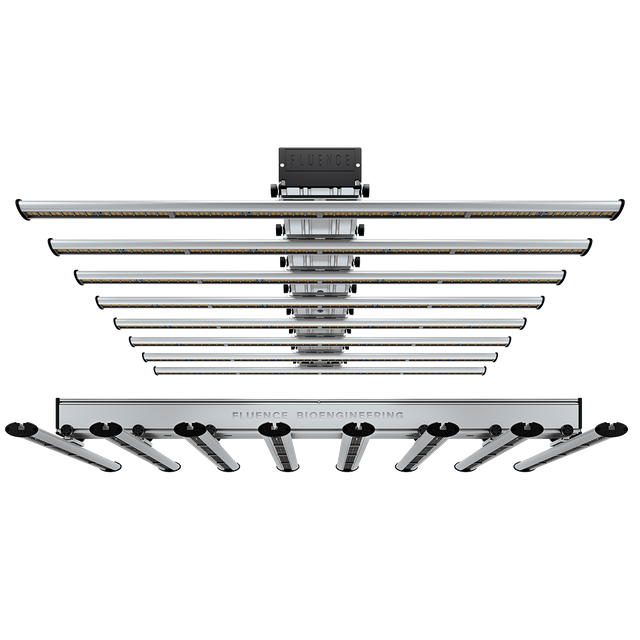RayonLED GLMF-720W FOLDABLE LED Grow Light VS Fluence SPYDRx Plus 685W LED Grow Light
Over the years, lists of the best LED grow lights for 3×3 tents have changed as new technologies emerged, pushing older technology out of its current place. So in this guide I’m going to round up the best LED grow lights for your 3×3 tent!
I will give you more information about this LED grow light, especially in the second half of this guide.
For everyone’s benefit, this guide is dedicated to helping you not only improve your indoor grower plants, but also help you save money!
RayonLED GLMF-720W FOLDABLE LED Grow Light

Features:
With its impressive expertise in LED technology, this medical-grade device has everything to appeal to hobby and commercial growers. The RayonLed grow light is designed to replace and surpass the results of 1000W HID fixtures. What’s more, the fixture has a dedicated UV-IR strip that can be controlled independently. From spectrum to certification, it’s engineered to compete with the top grow lights on the market. Passively cooled light bars provide full spectrum, broad coverage light for long-term growth. High output 1944 µmols PAR! and an impressive efficacy of 2.7 µmol/s per watt. The unit features UV and far-red light strips to provide the most complete spectrum on the market today! IP65 certification allows lights to function and last in even the wettest grow rooms
Fluence SPYDRx Plus 685W LED Grow Light
Features:
The Fluence grow light is a full-cycle top lighting solution for commercial horticultural planting with the ability to grow from vegetative to flowering. The SPYDR series is only 4.6" thick, with a recommended installation height of only 6" from the top of the canopy, and is designed for vertical farming — from vegetables to flowering — with an average PPFD of up to 1,030 µmol/m2/s on a 4'x4' top on the canopy. All SPYDR models can be dimmed with an optional light intensity Dimmer for precise control of the PPFD and provide flexibility to instantly adapt to new crops with varying light requirements. Recommended installation height is 6" for optimal light uniformity, penetration and flux density above a 4'x4' canopy.
Factors That Affect LED Choice
There are two factors that you need to consider when choosing the wattage of the LED Grow Lights.The first would be the plant you’re growing, and the second would be the total area of your grow space.
Type of Plant
Plants have different lighting needs, which is why you need to know how much light a plant needs. As a rule of thumb, the higher the wattage, the more intense the light is. Leafy plants and herbs usually need lower wattages. Fruit and flowering plants like tomatoes need higher wattages. The amount of power you need for leafy plants would often be half of what a flower-bearing plant needs.
When it comes to the total grow space area, this pertains to how much space your plants cover and not the footprint of your space. That will help you also decide how much wattage you need for every plant.
Different growing techniques are a consideration in the total area of growth. And while that affects wattage, you can’t just split the light to get the right amount of power. Instead, you can use that light in a position that can help benefit multiple plants.
So, how much do you need per plant per area?
Thirty-two watts of power should be enough for every square foot as a rule of thumb. You can go a bit low to 30, but don’t go beyond 40 per square foot. So how good is a 32-watt LED?
Let’s take the Screen of Green technique as an example. A Screen of Green needs about 0.25 square feet of grow space. With a 32-watt LED grow light, you can provide enough lighting for four plants. For a Sea of Green, the same 32-watt grow light can provide lighting for one plant.
On the other hand, 32-watts of power won’t be enough for a low-stress training, which occupies at least two square feet of grow space.
As you can see, you can use a grow light for multiple plants. But take note that it’s not ideal to do so all the time. For one, the lighting coverage on the outer part of the light’s footprint isn’t as beneficial as being close to the center. And while you can cram plants under a grow light, the results won’t be as helpful.
Sounds simple? There are some considerations to consider with the grow space and wattage.
Photosynthetically Active Radiation (PAR)
PAR, or photosynthetically active radiation, is just as important to know when deciding how much lighting you need to grow your plants. PAR measures the intensity you need to grow your plants. To give you an idea, leafy plants need around a PAR of 200, while fruit-bearing plants would thrive between 400–500, depending on the plant.
Knowing how much PAR a grow light has will affect how a plant grows. If the PAR is too low, your plant will have a hard time growing and will likely have stunted growth. Too intense lights, meanwhile, can burn your plants. That’s why LED grow lights need to be set at an optimal height, even with the lower heat emission.
Conclusion
Keep in mind the various grow lights for different stages of plant growth:
Choose white light for all stages of the plant growth cycle
For early growth stage lights, choose blue grow lights
If you want to promote flowering, red grow lights are the best choice for you
Whether you’re permanently growing your plants indoors, or growing them outdoors indoors, grow lights can help keep your plants healthy. Hopefully we’ve given you some ideas on how to use grow lights for your houseplants.
